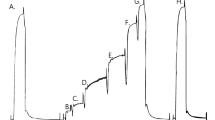Summary
The relationship between the myosin heavy chain (HC) IId isoform and histochemically defined fibre types was investigated in the rat soleus muscle after hindlimb suspension. After 4 weeks of suspension, right and left muscles were removed and fibre type composition and total fibre number were examined by histochemical myosin adenosine triphosphatase staining sections. Myosin HC isoforms were analysed by sodium dodecyl sulphate polyacrylamide gel electrophoresis. After the suspension, there was a significant decrease in the percentage of type I fibres and a concomitant increase in that of type IIa fibres. However, the total number of fibres was not affected by suspension. The synthesis of HC IId isoform, which was not found in the control, and the decrease in the ratio of slow type myosin heavy chain isoform (HC I) were observed after suspension. These results would may suggest that the change of fibre type composition was caused by a shift from type I to IIa fibres after suspension. Furthermore, it could be suggested that the synthesis of HC IId isoform occurred during the stage of type shift from type I to IIa fibres.
Similar content being viewed by others
References
Bar A, Pette D (1988) Three fast myosin heavy chains in adult rat skeletal muscle. FEBS Lett 235:153–155
Billeter R, Heizmann CW, Howald H, Jenny E (1981) Analysis of myosin light and heavy chain types in single human skeletal muscle fibers. Eur J Biochem 116:389–395
Booth FW, Kelso JR (1973) Effect of hind-limb immobilization on contractile and histochemical properties of skeletal muscle. Pflügers Arch 342:231–238
Brooks MH, Kaiser KK (1970) Muscle fiber types: how many and what kind? Arch Neurol 23:369–379
Corley K, Kowalchuk N, McComas AJ (1984) Contrasting effects of suspension on hind limb muscles in the hamster. Exp Neurol 85:30–40
Danieli Betto D, Zerbato E, Betto R (1986) Type 1, 2A, and 2B myosin heavy chain electrophoretic analysis of rat muscle fibers. Biochem Biophys Res Commun 138:981–987
Desplanches D, Mayet MH, Sempore B, Flandrois R (1987) Structural and functional responses to prolonged hindlimb suspension in rat muscle. J Appl Physiol 63:558–563
Doriguzzi C, Mongini T, Palmucci L, Schiffer D (1983) A new method for myofibrillar Ca++-ATPase reaction based on the use of metachromatic dyes: its advantages in muscle fibre typing. Histochemistry 79:289–294
Elder GCB, McComas AJ (1987) Development of rat muscle during short- and long-term hindlimb suspension. J Appl Physiol 62:1917–1923
Kugelberg E (1976) Adaptive transformation of rat soleus motor units during growth. J Neurol Sci 20:269–289
Morey ER (1979) Spaceflight and bone turnover: correlation with a new rat model of weightlessness. Bioscience 29:168–172
Oishi Y, Ishihara A, Katsuta S (1992) Muscle fibre number following hindlimb immobilization. Acta Physiol Scand 146:281–282
Perrie WT, Bumford SJ (1986) Electrophoretic separation of myosin isoenzymes. Implications for the histochemical demonstration of fibre types in biopsy specimens of human skeletal muscle. J Neurol Sci 73:89–96
Schiaffino S, Ausoni S, Gorza L, Saggin L, Gundersen K, Lomo T (1988) Myosin heavy chain isoforms and velocity of shortening of type 2 skeletal muscle fibres. Acta Physiol Scand 134:575–576
Sugiura T, Murakami N (1990) Separation of myosin heavy chain isoforms in rat skeletal muscles by gradient sodium dodecyl sulfate-polyacrylamide gel electrophoresis. Biomed Res 11:87–91
Sugiura T, Matoba H, Miyata H, Kawai Y, Murakami N (1992) Myosin heavy chain isoform transition in ageing fast and slow muscles of the rat. Acta Physiol Scand 144:419–423
Takahashi H, Wada M, Katsuta S (1991) Expressions of myosin heavy chain IId isoform in rat soleus muscle during hindlimb suspension. Acta Physiol Scand 143:131–132
Templeton GH, Sweeney HL, Timson BF, Padalino M, Dudenhoeffer GA (1988) Changes in fiber composition of soleus muscle during rat hindlimb suspension. J Appl Physiol 65:1191–1195
Termin A, Staron RS, Pette D (1989a) Myosin heavy chain isoforms in histochemically defined fiber types of rat muscle. Histochemistry 92:453–457
Termin A, Staron RS, Pette D (1989b) Changes in myosin heavy chain isoforms during chronic low-frequency stimulation of rat fast hindlimb muscles. Eur J Biochem 186:749–754
Author information
Authors and Affiliations
Rights and permissions
About this article
Cite this article
Oishi, Y. Relationship between myosin heavy chain IId isoform and fibre types in soleus muscle of the rat after hindlimb suspension. Europ. J. Appl. Physiol. 66, 451–454 (1993). https://doi.org/10.1007/BF00599620
Accepted:
Issue Date:
DOI: https://doi.org/10.1007/BF00599620




